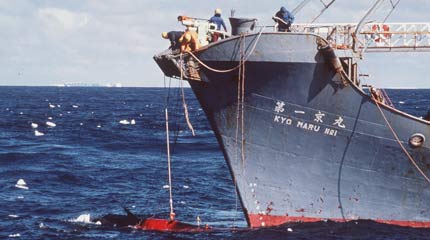
Japanese whalers harpooning a minke whale
Whales face threats from many sources, including pollution and climate change, but they are most directly threatened by commercial whale hunting. 1100 were killed for profit in 1998 alone, and the numbers are increasing every year.
Sanctuaries (the word means 'a safe place', or 'a place of refuge') give whales freedom from one of these threats: commercial whaling. Greenpeace wants to strengthen current protection for whales by implementing a series of regional sanctuaries, which will act as stepping stones in the longer term towards a Global Whale Sanctuary and a permanent end to all commercial whaling.
The body responsible for ensuring the healthy state of whale populations, the International Whaling Commission, agreed in 1979 to establish the Indian Ocean Whale Sanctuary, protecting whales in their breeding and calving grounds. Fifteen years later, in 1994, the IWC established the Southern Ocean Sanctuary. This covers all waters surrounding Antarctica and protects three-quarters of the world's whales in their feeding grounds.
At the 1998 meeting of the IWC, plans for two further sanctuaries were put forward. These included the South Pacific Whale Sanctuary, suggested by Australia and New Zealand and the South Atlantic Sanctuary, proposed by Brazil. If accepted, these new sanctuaries would start where the Southern Ocean Sanctuary ends. This coverage from the freezing waters of the Antarctic to the warm waters of the equator is vital. Most of the great whales are highly migratory, feeding in the nutrient-rich waters of the Antarctic before travelling to tropical waters to give birth and suckle their young. They then make the long migration back to their feeding grounds.
Since whales rarely cross the equator, establishment of these sanctuaries would mean that the whales of the Southern Hemisphere could live their entire lives in an area free from commercial whaling.
In addition to promoting research and conservation, sanctuaries will help encourage whale watching and the industry that develops around it. Increasing numbers of people who have seen whales in their natural habitat are supporting global shelter for them. They want to see the whales they watch protected, not being hunted.
Sanctuaries are a forward-thinking measure. They make economic sense, help protect whales and encourage research on whales and the environment. They send a clear message of hope that the world is turning away from whaling and that there will be no return to the commercial hunting which devastated one population after another.

